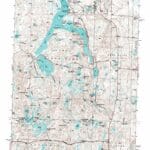Want to explore the landscape and property details of Tallapoosa County, Alabama? Its Geographic Information System (GIS) offers a wealth of data, from property lines and tax assessments to floodplains and voting districts. This guide provides an overview of what’s available, how to access it, and its practical applications for residents, businesses, and government officials. We’ll also touch on potential future developments.
Exploring Tallapoosa County’s GIS Data
Tallapoosa County’s GIS is a powerful tool for understanding the county’s geography and property details. It’s a digital map packed with layers of information, offering valuable insights into the area.
Accessing the GIS Treasure Trove
The primary source for Tallapoosa County GIS data is the Tallapoosa County Mapping and Appraisal Department. Their website likely offers interactive maps, aerial photography, and vital property tax and appraisal information. Their office in Dadeville provides in-person assistance.
Other online platforms like CountyOffice.org, AcreValue.com, and Acres.com may offer compiled data, including property maps and ownership records. However, for critical decisions, verifying information with official county records is always recommended.
Additional data may be accessible through the Alabama Open Data Portal, potentially including road information from the US Census Bureau. Websites like AcreValue.com and Acres.com often provide plat maps with detailed property boundaries and ownership information. Resources like Lolaapp.com might offer helpful guides for navigating Tallapoosa County’s GIS data.
Understanding Key Data Points
Navigating the wealth of GIS data can be overwhelming. This table summarizes some key data points and their significance:
| Data Point | What it Tells You | Example (Illustrative) |
|---|---|---|
| Parcel Count | The total number of individual properties in the county | 35,000+ |
| Average Building Size | The typical size of buildings in the county | Around 1,585 sq ft |
| Average Lot Size | The typical size of a piece of property | Approximately 1.71 acres |
| Average Property Taxes | The average amount paid in property taxes each year | Roughly $450 annually |
| Median Assessed Value | The midpoint value of all assessed property values | Around $117,000 |
| Median Sale Price | The midpoint value of recent property sales | Around $195,000 |
| Construction Years | The range of years when most buildings were constructed | Mostly 1952-2000 |
These figures represent a general overview and may vary. Median values are generally considered more representative than averages, as they are less susceptible to being skewed by outliers. While the median sale price might suggest a typical property cost of around $195,000, a closer look at specific neighborhoods and property types is crucial for a more accurate picture.
Practical Applications of Tallapoosa County GIS
The GIS offers practical benefits for various users:
- Homebuyers: Research a property’s history, past ownership, assessments, and building age.
- Developers: Analyze land use, zoning regulations, and potential environmental concerns.
- Government Officials: Support urban planning, infrastructure improvements, and emergency response (e.g., identifying flood-prone areas).
The Future of Tallapoosa County GIS
The future of GIS is promising, with advancements like 3D modeling and real-time data updates poised to revolutionize how we interact with geospatial information. Integrating GIS with other datasets offers vast potential. These advancements may bring more detailed and user-friendly information to Tallapoosa County.
What is GIS in Georgia? A Comprehensive Guide
While we’ve discussed GIS in Tallapoosa County, AL, let’s explore what GIS means in the context of Georgia. A Geographic Information System (GIS) transforms traditional maps into dynamic tools by integrating location-based data. This allows for a deeper understanding and management of resources and infrastructure across diverse landscapes, from urban centers to rural areas.
Georgia’s GIS Landscape: A Powerful Tool for Diverse Needs
Georgia utilizes GIS extensively across various sectors, providing a platform for informed decision-making and efficient resource allocation.
State Government: Enhancing Efficiency and Planning
Georgia’s state agencies likely utilize GIS for core functions:
- Transportation: The Georgia Department of Transportation (GDOT) probably uses GIS for highway planning, traffic management, and infrastructure maintenance, visualizing traffic patterns and identifying areas for improvement.
- Natural Resources: The Department of Natural Resources may use GIS to monitor wildlife, manage parks and forests, and track environmental changes, supporting conservation efforts.
- Public Health: GIS can be a vital tool for tracking disease outbreaks, allocating resources, and planning public health interventions.
Local Impact: Empowering Communities
At the local level, counties and cities likely employ GIS for:
- Property Tax Assessment: Unlike the initial inquiry regarding Tallapoosa County, AL, we’re focusing on how Georgia counties use GIS for accurate property valuations.
- Urban Planning: GIS aids in analyzing population growth, identifying development areas, and planning infrastructure upgrades.
- Emergency Response: GIS supports optimizing emergency routes and improving response times.
Business Applications: Driving Innovation
Businesses across various sectors in Georgia likely leverage GIS for:
- Agriculture: Precision agriculture techniques powered by GIS optimize crop yields and resource management.
- Real Estate: GIS aids in market analysis, site selection, and risk assessment.
- Utilities: Companies manage infrastructure networks, monitor assets, and plan maintenance using GIS.
Education and Careers: Shaping Georgia’s GIS Future
Georgia’s educational institutions offer programs in Geographic Information Science, equipping students with skills for a range of GIS careers. The demand for GIS professionals is growing, creating diverse opportunities across various sectors.
Accessing Georgia’s GIS Data
Georgia offers public access to a wealth of GIS data through various online portals. These resources empower researchers, businesses, and individuals to gain insights and contribute to a better understanding of the state.
The Future of GIS in Georgia
The GIS field is constantly evolving, with emerging technologies like drone mapping and AI integration creating even more powerful tools. This suggests a continued expansion of GIS applications in areas like urban planning, environmental management, and economic development.
Tallapoosa County Lodging Tax: What Short-Term Rental Owners Need to Know
Effective December 1, 2023, Tallapoosa County implemented a 10% lodging tax on short-term rentals in unincorporated areas. This guide provides essential information for rental owners.
Understanding the 10% Lodging Tax
This tax applies to all short-term rentals within the unincorporated areas of Tallapoosa County, similar to taxes levied on hotels. It affects properties rented through platforms like Airbnb and VRBO. “Unincorporated” refers to areas outside the boundaries of incorporated cities or towns.
What’s Included in the Tax?
The 10% tax applies to the total cost of the stay, including cleaning fees, service charges, and any other mandatory fees. This simplified, all-inclusive approach streamlines the calculation process.
Paying the Lodging Tax
Tallapoosa County has made lodging tax remittance straightforward through an online system. The Alabama Department of Revenue’s “Local Tax” account provides a centralized platform for reporting earnings, calculating tax owed, and making payments.
Why This Tax? Following the Alabama Trend
Tallapoosa County joins a growing number of Alabama counties implementing lodging taxes to generate revenue from the increasing popularity of short-term rentals. These funds typically support local services like infrastructure improvements and public safety initiatives.
Looking Ahead: Potential Impacts
The long-term impact of the tax is still unfolding. While it’s projected to generate significant revenue, its effect on the short-term rental market remains to be seen. Monitoring announcements from the county and engaging with local rental associations is advised.
How to Contact Mecklenburg County, NC GIS
Mecklenburg County, NC, offers a robust GIS system. Here’s how to connect with their GIS experts and access their resources. Note: This refers to Mecklenburg County, North Carolina, not Virginia.
Connecting with the GIS Team
- Phone: 704-336-6175 (for address assignments and general inquiries)
- Email: [email protected] (for less urgent requests or detailed information)
Exploring Online Resources
- Website: gis.mecknc.gov (central hub for GIS information)
- GeoPortal: Access this interactive mapping tool via the main website to explore data layers, search by address or parcel number, and conduct research.
Utilizing Key Services
- Land Records: Access property ownership details, address history, and related information on the GIS website. An FAQ section may answer common questions.
- Addressing: This division handles address locations and road centerlines, vital for emergency services and building permits.
Benefits of Using Mecklenburg County GIS
| User Group | Benefits |
|---|---|
| Residents | Property research, school zone identification, understanding local regulations |
| Businesses | Market analysis, site selection, planning and development |
| Government Officials | Emergency management, urban planning, infrastructure development |
Future of Mecklenburg County GIS
The county likely anticipates ongoing improvements to its GIS system, potentially including enhanced accessibility, technology integration, and more valuable features.
Navigating Uncertainties
While GIS data is invaluable, it’s essential to be aware of potential data limitations or errors. Contacting the GIS team directly is advisable for any concerns regarding data accuracy.
Discover more about geospatial data in other regions through the Sampson County NC GIS platform and explore Alabama’s diverse landscape with the Talladega County GIS portal.
- Find Top Hero Books: Epic Journeys Now - April 17, 2025
- Types of Drainage Systems: Choosing the Right Solution for Your Property - April 17, 2025
- Grow Gorgeous Annual Plants: Sustainable Guide for Vibrant Blooms - April 17, 2025
















1 thought on “Unlocking Tallapoosa County, AL with GIS: A Comprehensive Guide to Parcel Data, Tax Maps, and Property Records”
Comments are closed.